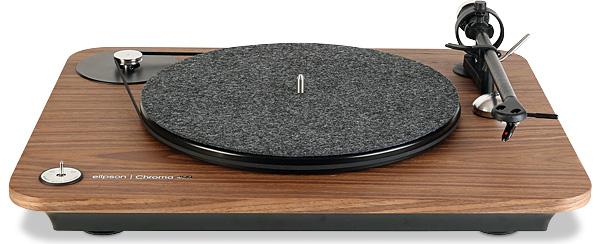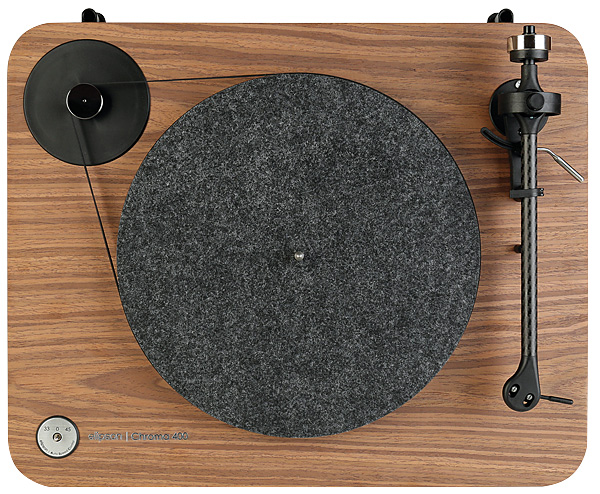Elipson Chroma 400 Turntable Package

With enthusiasm for vinyl showing no sign of diminishing, many companies are now launching record players in a bid to reel in buyers. For the most part this process sees them approach an existing turntable manufacturer and select anything between core components on which to base their own design, to a complete 'turnkey' unit, requiring only the application of branding and a name.
Elipson has taken a different tack with its Chroma decks. Aside from the choice of Ortofon OM10 cartridge mounted on the tonearm used for each model, the turntables share very little with other record players on the market. And neither is the French company drawing on any great design heritage when it comes to analogue replay.
Knuckle Under
The Chroma models replace the brand's Alpha and Omega lines and are divided into the 200 and 400 series. Each of these lineups features a conventional turntable, as reviewed here, that requires a connection to an external phono stage. In addition, both the 200 and 400 series include an 'RIAA' deck with onboard phono stage, and an 'RIAA BT' version that combines the phono stage with a Bluetooth transmitter to connect wirelessly to your system. These built-in electronics cannot be bypassed in either the RIAA or RIAA BT models, so it's the basic Chroma 400 that offers the greatest upgrade potential.
The Chroma 400 is a belt-driven, unsuspended design with a relatively deep plinth comprising a plastic lower body and upper MDF section. This reflects the need for other models in the lineup to accommodate a phono stage and other circuitry within. In all cases, the plinth houses the AC motor, which sits inside a damped housing to reduce vibration. The motor itself offers electronic speed selection (33.33 and 45rpm) although when either is selected via the toggle switch to the left of the plinth, there's a 1-2 second pause before rotation begins that's just long enough for you to wonder if the deck has ceased functioning...
The belt from the motor runs around the outer edge of the upper platter, the subplatter underneath serving purely to spread the contact between the spindle and the plinth. Fitting the belt is a little fiddly, but it does tend to stay put once in place. A relatively thick felt mat is supplied and it is very much advised to use it.

A novel aspect of the turntable is its arm. Called the Orbital Torsion Tonearm (OTT), it works by combining horizontal and vertical movements into a single knuckle that's on the same axis as the armtube. A ring-shaped assembly then extends around the knuckle to support it.
Gallic Charm
This orbital yoke is also used to mount the antiskate system, which comprises a length of elastic that descends through the centre of the 'bearing' and is adjusted via a knurled control at the top. In the Chroma 400 models, the armtube is fashioned from carbon-fibre while on the 200 models aluminium is used instead. The headshell and knuckle sections are plastic and are common to both the 200 and 400 series.
There are some useful refinements to the OTT arm for this generation too. The original model had no armlift, which meant manual cueing only, while the counterweight is now easier to set than before. The arm does have its niggles, however – the lift is undamped so care needs to be taken when dropping the cartridge into position, particularly as the recommended downforce for the Ortofon OM10 cartridge is a relatively low 1.5g.
Minor quirks aside, the Chroma 400 is not short on appeal. As it shares so little of its core design with rivals, it looks and feels suitably distinctive. If you are a 'first-timer' then you'll not know the difference but otherwise the deck, and particularly the arm, might come across as being less substantial than equivalent designs. It is reasonably well made, however.
It also manages to convey something of the Gallic quirkiness of some French engineering without this undermining user-friendliness. Little details such as the rounded edges of the lid and the toggle switch to select speed are key points of contact that feel pleasantly tactile. The supplied domed aluminium 45rpm adapter is a particularly attractive object, and this can also be purchased separately.
The review sample was finished in the new 'walnut' option that has been added to the range along with a lighter 'oak', and these command a price premium of £50 over the pre-existing black, red and white gloss finishes. Were it me, I'd pocket the £50 and go for a red one as I feel it complements the lines of the Chroma 400 most effectively, but the wood finishes are certainly appealing enough.
![]() Flow Motion
Flow Motion
Hooked up to a Cyrus Phono Signature phono stage, Chord Electronics CPM2800 MkII integrated amp and Kudos Titan 505 speakers, the Chroma 400 immediately revealed its strengths. The manner in which it tackled 'Ode To The Big Sea' on Motion, the 1999 debut album from British 'nu jazz' group The Cinematic Orchestra [Ninja Tune ZEN45] was effortless, especially given the deck's affordable price, the track's distinctive 3/4 time signature flowing from the loudspeakers.


















































